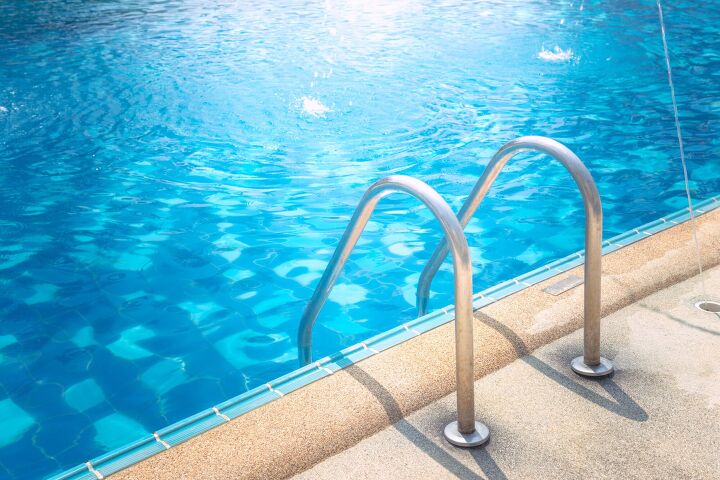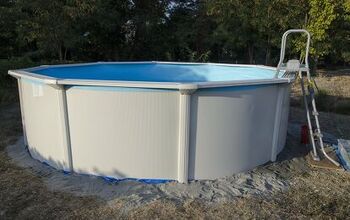How Much Does It Cost To Fill In A Pool?

A swimming pool can be a terrific investment due to the value it adds and just how useful it is. If you have a swimming pool at home, you can use it for exercising or cooling down during the summer. Unfortunately, there’s also a chance that your swimming pool may largely go unused.
For whatever reason, that swimming pool you paid for is now just taking up space in your yard. Instead of being an asset, it’s now actively taking valuable space away from you. The good news is you can still fill in your swimming pool and make use of the space it’s taking up.
You can partially fill in your unused swimming pool with dirt so it no longer gets in the way. On average, you’ll have to pay $6,100 to get your old swimming pool filled with dirt. The price will change depending on the size of your swimming pool. Completely removing your pool is also an option, but that will cost $10,400.
A consistently unused swimming pool is not a positive addition to your property. You should consider filling it in so it no longer gets in the way all the time. Find out how much filling in your swimming pool will cost by continuing with the rest of this article.
Do You a Need Pool, Spa, or Hot Tub Contractor?
Get free, zero-commitment quotes from pro contractors near you.

Cost to Fill in a Pool with Dirt
| Swimming Pool Size | Cost |
| 10’ x 20’ | $4,100 |
| 14’ x 28’ | $5,000 |
| 15’ x 30’ | $5,300 |
| 20’ x 40’ | $6,700 |
| 30’ x 50’ | $9,400 |
Leaving your swimming pool unused for long periods is not ideal. A swimming pool may even sustain damage if it’s left without water for a long time. Instead of worrying about your unused pool, you can just fill it in with dirt for the average price of $6,100.
Note that the average cost of filling in a swimming pool we mentioned already includes labor. It’s important to entrust this job to the professionals because an improperly filled pool can pose a danger to your property. The rubble may sink further down into your land and cause a lot of damage in the process.
The process of filling in a swimming pool starts with holes being made. Those holes are carved out on the pool’s bottom surface. The walls of the swimming pool are then torn down.
To finish up, the workers must then cover the rubble of the swimming pool with dirt. The amount of dirt needed for filling in will differ depending on the size of the pool.
60 cubic yards of dirt may suffice for a small swimming pool that only measures 10 feet by 20 feet. A medium-sized pool that measures 15 feet by 30 feet may require 135 cubic yards of dirt. For a large pool that measures 30 feet by 50 feet, you will probably need 240 cubic yards of dirt.
Other Ways to Fill in the Pool
Using on its own is probably the most common way of filling in a swimming pool. However, that doesn’t mean it’s the best way of occupying that void.
The issue with only using dirt is that it won’t stabilize the area where the swimming pool used to be. Once the dirt and debris settle into place, the surface of that compacted area may feel uneven. You may want to use other materials along with the dirt to stabilize that spot.
Use Dirt and Stone
Aside from dirt, you can also use some stones to fill in the pool. The stones are helpful because they add the stability you need.
The workers can position the stones strategically so they keep the pieces of debris in place. They will prevent the debris from moving and that will stop the ground from shifting. Of course, the cost of filling in your pool will increase if you’re using both dirt and stone.
Use Dirt and Concrete from Demolition
Another method of filling in the swimming pool involves using dirt and concrete from your swimming pool. The workers will keep the debris in there and even arrange it so it doesn’t move around too much. You won’t have to pay extra for materials, but the workers may charge more to arrange the concrete debris.
Should You Fill in Your Pool?
The decision to fill in your pool is not one you can take lightly. What you end up doing to that space can shape your outdoor landscape moving forward.
Your filled-in pool doesn’t have to be a permanent fixture of your yard. However, doing something about it will cost a lot more money.
In this section, we’re going to discuss the pros and cons of filling in your swimming pool. Take note of them as you decide what to do.
Pros:
- Reclaim Your Yard – Your swimming pool may be occupying a sizable chunk of your yard. Filling in your pool will allow you to make use of that area again.
- Repurpose the Space – Plant trees where the pool used to be and maximize that space. You can also install some other yard décor to beautify that area.
- Cost-Effective – Filling in your pool is more affordable than removing it completely. If you don’t want to spend too much on reclaiming your yard, filling in the pool is a good option.
- Materials Already Available – Dirt is the material mainly used to fill in swimming pools, but concrete is an option too. To be more specific, the concrete used for the swimming pool can be broken up and used as a backfill.
- No Supervision Required – An engineer will have to monitor the project if you’re getting a pool removed. That is usually not the case for filling in the pool.
- Quick Completion – Filling in your swimming pool is faster than removing it. If you need your yard ready as soon as possible, filling it in with dirt is the move to make.
Cons:
- Area Is Susceptible to Sinking – Sinking is a possibility if you’re just filling in the pool instead of removing it. Removing the rubble that has sunk into your property can be costly.
- No New Structures – Building over your filled-in swimming pool is not an option because of the aforementioned sinking issue. You’ll be limited in terms of what you can do with that space.
- Buyers Need to Know – You have to tell potential home buyers if there is a filled-in pool found underneath your yard. The presence of that filled-in pool may cause them to reconsider their purchase.
- Lower Home Value – The filled-in pool sitting underneath your backyard can drag down the overall value of your home. Remember that if your long-term plans involve selling your home eventually.
Cost to Remove In-Ground Pool
| Swimming Pool Size | Cost |
| 10’ x 20’ | $7,500 |
| 14’ x 28’ | $8,900 |
| 15’ x 30’ | $9,300 |
| 20’ x 40’ | $11,200 |
| 30’ x 50’ | $15,200 |
Filling in your pool clears your yard, but it may not provide the space you need. If you want to use the space currently occupied by your pool for a new structure, you must remove it first. The average cost of removing an in-ground swimming pool is $10,400.
The cost of removing your swimming pool can climb as high as $15,200. It can also fall to $7,500. The size of your swimming pool is going to have a huge impact on the final price.
Fully removing an in-ground swimming pool is a tougher job for professionals. Every part of your swimming pool will have to be removed. That could be a long and laborious undertaking for the workers.
An engineered backfill must also be used for the area your swimming pool previously occupied. The engineered backfill adds much-needed stability. It’s the reason why you will be able to build over that spot again.
Crucially, an engineer must be present throughout this process. They have to monitor how the job is done so they can clear you to build on that part of your yard again. If there is no engineer to oversee the project, you will not be granted clearance.
Additional Cost to Remove In-Ground Pool Because of Material
Removing an in-ground swimming pool can be a costly endeavor. It can become more affordable or more expensive depending on the material makeup of your swimming pool. Let’s go over the common swimming pool compositions and how they impact the cost of removal.
Concrete
Workers will ask for more money if you’re asking them to remove a concrete swimming pool. That’s mainly because concrete is a strong material. To destroy and remove the concrete shell, the workers will need to use more powerful pieces of equipment.
The upside to getting a concrete pool removed is that you can save money on backfill. The concrete rubble can also be used as a backfill so you won’t have to purchase as much filler.
Fiberglass
The fiberglass shell of an old swimming pool is easier to remove compared to concrete. You won’t have to pay as much to get that removed.
You should know that the fiberglass shell cannot be used as filler. That means you’ll need to use more engineered backfill to occupy the hole in your yard.
Vinyl
A vinyl liner is similar to fiberglass in the sense that workers won’t charge extra to remove it from your yard. It’s easy to remove so using heavy equipment will not be necessary. Once again, vinyl cannot be used as filler so you’ll need more engineered backfill.
Cost Factors for Removing an In-Ground Pool
Many homeowners end up paying a lot of money to get an in-ground pool extracted from their yard. Let’s examine why that project often ends up being expensive by taking a closer look at the different cost factors involved.
Permits
You may have to secure a permit before the pool removal project can even begin. The average cost of a pool removal permit is $150.
Not all areas require homeowners to secure a permit before pool removal. Check with your contractor or the local laws in your area to determine if a permit is indeed required.
In addition to the pool removal permit, another permit may be required depending on the location of your pool. That could tack on an additional $50 to your list of expenses. Spending $200 on permits is not ideal, but it beats paying some hefty fines.
Engineer Fees
The local laws in your area may indicate that a licensed engineer must oversee the removal of your swimming pool. If that’s the case, you’ll need to compensate the engineer for their time. Engineers will usually charge $750 to oversee this kind of project.
So, should you still hire an engineer if your local laws indicate that doing so is not required? That will depend on what your plans are for that filled-in space.
The engineer is there to determine if the filled-in spot can support a new structure. They will file a report indicating if the space in question can handle a new structure or not. If you intend to build on that spot again in the future, you need to hire an engineer.
Hiring an engineer is still wise even if you don’t think you’ll want to build on that spot again. If you ever change your mind, you can just build on that spot again instead of paying for removal first.
Labor Costs
Included among the main cost factors for in-ground pool removal are your labor expenses. Expect to pay $2,000 in labor expenses for this kind of project.
Look for contractors in your area if you want your in-ground pool removed. Once you’ve hired a contractor, they are the ones who will find the workers to take on this job. You can save money by hiring a contractor and other workers who already reside in your area.
The contractor can manage this project and lead the workers. They can also introduce you to a licensed engineer if you’re planning to hire one. Your contractor may even be able to secure the needed pool removal permit.
Backfill Materials
Different materials can be used as a backfill after the swimming pool has been removed. Typical pool backfill is made up mostly of dirt. You’ll have to pay $20 per cubic yard for the fill dirt required for this project.
In addition to the dirt, some topsoil is also added to the area where the pool used to be. Topsoil costs $25 per cubic yard, but only a little bit of it is needed to complete the backfill.
Gravel can also be added to the backfill to make the spot more stable. You will have to pay $45 for every cubic yard of gravel that you want to get added.
After you’re done deciding what kind of backfill mixture you want, the workers will place it inside the vacant spot. They will then compact it to increase its strength. Compacting will be necessary if you wish to build over that part of your yard again.
Debris Removal
Lastly, debris removal is another factor that will affect how much you’ll ultimately have to spend on this project. You cannot have the remnants of your old pool sitting on your property. Those broken pieces of the pool must be disposed of properly.
Note that you will have to pay extra if you want the workers to remove the pool debris. They usually charge $280 for that service.
Apart from the added labor expenses, you may also have to rent a dumpster for the debris. The average cost of renting a dumpster is $360 per week. Hopefully, the workers can finish cleaning up your property quickly so you’ll only need the dumpster for a little while.
Labor Cost to Restore Damaged Landscape
| Estimate Type | Cost Per Hour |
| Low-End Estimate | $50 |
| Mid-Range Estimate | $100 |
| High-End Estimate | $150 |
Whether you opted to fill in your pool or had it removed, that patch of your yard is likely in rough shape. It may not fit in with the rest of your yard so you want a professional landscaper to restore it. Before hiring a landscaper, you should know that their average hourly rate is $100.
You may have to pay more if the damage to your yard is quite extensive. Go ahead and ask your contractor if they know a professional landscaper who can fix up your yard. They can save you some valuable time if they already know someone.
Work with that landscaper to bring your vision for your new yard to life. Tell them where you want the plants and trees to grow so they can make adjustments as needed.
Also, remember to inform your landscaper if you still have some building plans in mind. Let them know about your plans so they can keep certain areas open.
Do You a Need Pool, Spa, or Hot Tub Contractor?
Get free, zero-commitment quotes from pro contractors near you.

Related Questions
Can You Restore a Filled-In Pool?
Yes, restoring a swimming pool that you already filled in is still an option. However, that will cost a lot of money. The average cost of restoring a filled-in pool is $42,000.Given how expensive restoring a filled-in swimming pool can be, you may be better off just building a new pool. Building a new pool even allows you to try out some new designs.
What Can I Do with an Unwanted In-Ground Pool?
If you don’t have the money to fill in your unwanted pool just yet, you can still do other things with it. One option is to pay professionals to convert it into a deck.You can also use the space as a storage area or grow some plants there. Just make sure to modify the pool walls and floor so they don’t break due to the water table.
How Do You Restore an Old In-Ground Pool?
An old pool can still be restored even if it hasn’t been used for a while. It all starts with fixing any leaks and cleaning the pool up thoroughly.You should also inspect the attached pieces of pool equipment because they may already be busted. Replace them if they are exhibiting any signs of damage.

Gary Evans is passionate about home improvement. He loves finding out how to make improvements in the easiest, most practical, and most affordable ways. Upgrading his home kitchen is one of his ongoing hobbies. Gary is also a long-time content creator and enjoys spending his free time tending to his hydroponic vegetable garden.
More by Gary Evans













![How Much Do Pool Repairs Cost? [By Type & Material]](https://cdn-fastly.upgradedhome.com/media/2023/07/31/9103564/how-much-do-pool-repairs-cost-by-type-material.jpg?size=350x220)













